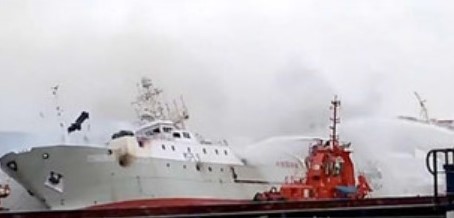In its latest Safety Digest, UK MAIB provides lessons learned from an incident where a ship became increasingly unstable due to water flooding from an attempt to cease a fire on board, and as the hull continued to fill, the vessel eventually capsized and partially sank on the berth.
The incident
A large ocean-going squid fishing vessel was moored alongside in a ship repair facility, undergoing scheduled maintenance. Most of the crew had gone on leave and the ship had been left in the shipyard’s care. A welder was carrying out repairs in one of the ship’s insulated cargo holds and inadvertently set fire to some insulation. Fortunately, he escaped from the hold and managed to raise the alarm.
As the fire intensified, it quickly spread to adjacent holds and the ship’s accommodation. The local fire service fought the fire, assisted by a harbour tug equipped with firefighting capability. The firefighters and tug deluged the vessel with water, which began to flood its hull.

Because its crew were unable to start the ship’s equipment and pump out the water, the ship became increasingly unstable as the hull continued to fill and it eventually capsized and partially sank on the berth.
Post-accident investigations identified that no fire watch was maintained to help the shipyard welder and no hand-held fire extinguishers were available where he was working. Several months later the vessel was refloated, but the fire and flood damage resulted in it being declared an insurance total loss and it was scrapped.
Lessons learned
#1 Risk: Hot work is always hazardous and a hot work permit should be in place before work begins. Risk reduction measures should include maintaining a fire watch in and near the hot work site and ensuring first response firefighting equipment is close to hand.
#2 Procedure: When placing a vessel into a shipyard facility, its management and crew should check that safe operating procedures are in place for the planned tasks; this includes ensuring availability of staff sufficiently conversant with ship’s systems to be able to deal with most emergency situations.
#3 Equipment: Vessel instability due to large volumes of water is an additional hazard when fighting fires on board ships. To prevent this, make sure there are available means to remove water from decks and compartments.































































